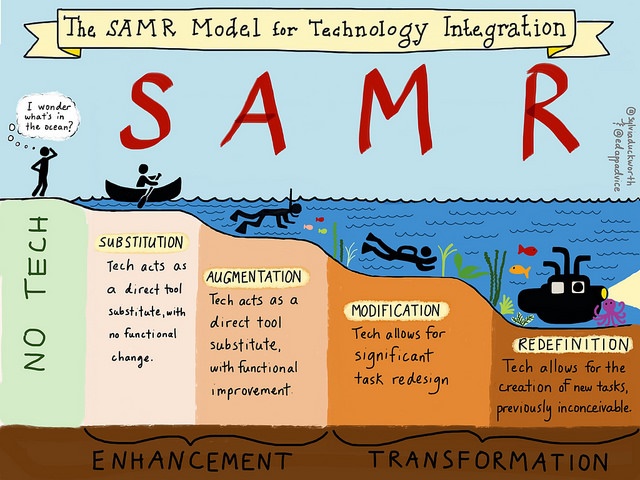In the ever-evolving landscape of education, teachers are constantly seeking innovative ways to engage their students and deepen their understanding. Enter the SAMR model—a framework that encourages educators to transform their teaching practices to higher levels of engagement and learning using technology integration. Here is a run-down on the basics of the SAMR model:
By moving beyond simple Substitution and incorporating Augmentation, Modification, and occasionally reaching Redefinition, teachers can empower students to utilize their skills for research, share their knowledge with peers, make connections, and develop a well-rounded understanding of the world. Beyond the model shown above, here are some simplified key points and examples that may help in understanding each stage of technology implementation:
- Substitution = Doing old things in old ways
- Examples: Replacing a manual GPS with a smartphone's GPS app; replacing a hardcopy of a dictionary with Google's "Define" function
- Augmentation = Doing old things in new ways
- Examples: Replacing hardcopy books with eBooks where the user can highlight sections, define vocabulary, and share the source with others; replacing paper maps with Google Maps where the user can see ratings for their destinations, images, fastest routes, hours of business operation; replacing the chore of handwashing dishes to using a dishwasher
- Modification = Doing old things in better ways
- Examples: Replacing hardcopy books with audiobooks so that the user can listen while completing other tasks, or so that a user who struggles with reading can engage audibly; using Google Drive rather than handwriting/printing numerous drafts of an essay, reducing paper waste and allowing the user to simply make changes rather than rewriting the same work multiple times
- Redefinition = Doing new things in new ways
- Examples: Transportation by airplane rather than by car or train, gaining access to the rest of the globe rather than being landlocked; using Venmo for payments rather than cash, increasing convenience while also reducing the risk of pickpocketing
Making connections is another crucial aspect of the SAMR model. Teachers can help students see the bigger picture by encouraging them to explore how their research and learning connect to other material or topics. By drawing parallels, students develop a holistic understanding of the subject matter and its relevance in various contexts. Engaging in conversations with individuals from different cultures and perspectives further broadens their horizons, challenging assumptions and nurturing empathy.
To achieve this, teachers can introduce redefinition by stretching the boundaries of traditional classroom experiences. Inviting guest speakers into the classroom, organizing virtual Zoom calls with experts from around the globe, and encouraging students to create their own unique renditions of projects are just a few ways to foster a deeper connection to the real world. These experiences inspire creativity, critical thinking, and problem-solving skills, transforming students into active contributors and shaping their understanding of the subject matter on a profound level.
Incorporating the SAMR model into lesson planning allows teachers to embrace the transformative power of technology and pedagogy. By gradually moving from substitution to augmentation, modification, and occasionally reaching redefinition, teachers empower students to become active learners, critical thinkers, and global citizens. With this approach, education becomes a dynamic and enriching journey, propelling students towards higher levels of engagement, understanding, and success.
With support from Generative AI


Thanks for providing so many clear examples for each part of SAMR! I think using this model to improve our lesson plans is a great step forward. We should always be striving to redefine the learning of our students! What I also love about this model is that everyone has their own opinion on what "redefinition" is, so it's a great tool to have in depth conversations with your colleagues and really start to bounce ideas off of each other.
ReplyDeleteWe have the tools....we know how to use the tools...so it a matter now of finding the right time and space to make these things happen. As I always tell myself...if I can't take my students out into the world, how to I bring the world to my students?
ReplyDelete